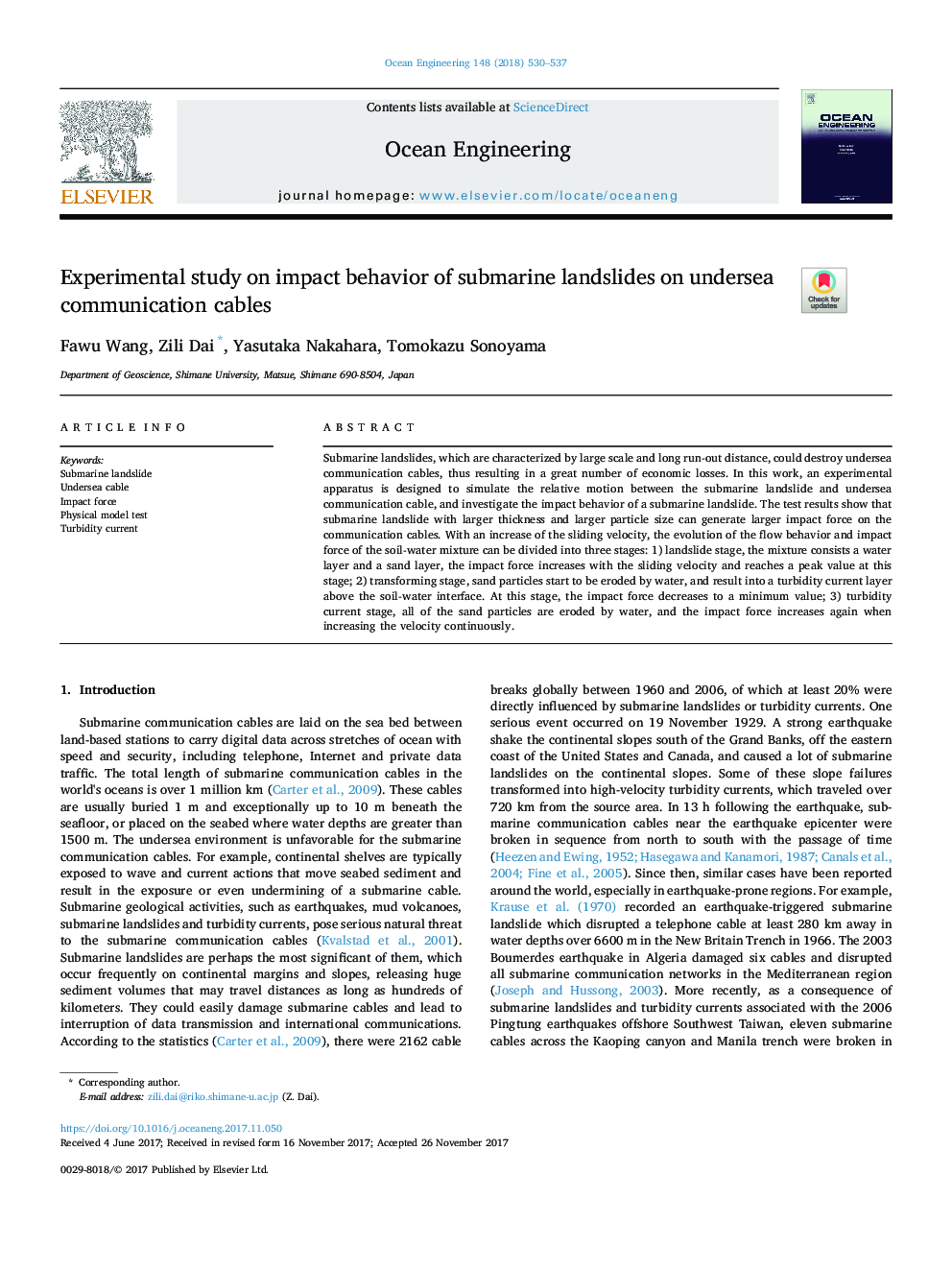| کد مقاله | کد نشریه | سال انتشار | مقاله انگلیسی | نسخه تمام متن |
|---|---|---|---|---|
| 8063638 | 1520642 | 2018 | 8 صفحه PDF | دانلود رایگان |
عنوان انگلیسی مقاله ISI
Experimental study on impact behavior of submarine landslides on undersea communication cables
ترجمه فارسی عنوان
مطالعه تجربی بر رفتار تاثیرات لغزش های زیردریایی بر روی کابل های ارتباطی زیردریایی
دانلود مقاله + سفارش ترجمه
دانلود مقاله ISI انگلیسی
رایگان برای ایرانیان
کلمات کلیدی
لغزش زیردریایی، کابل زیرین، نیروی ضربه، آزمون مدل فیزیکی، کدورت فعلی،
ترجمه چکیده
زمین لغزش های زیردریایی، که با فاصله زیاد و طولانی مشخص می شود، می تواند کابل های ارتباطی زیرین را از بین ببرد، در نتیجه تعداد زیادی از زیان های اقتصادی را از بین می برد. در این کار یک دستگاه آزمایشی برای شبیه سازی حرکت نسبی بین زمین لغزش زیردریایی و کابل ارتباطی زیر دریایی طراحی شده است و رفتار ضربه ای یک لغزش زیردریایی را بررسی می کند. نتایج آزمون نشان می دهد که لغزش زیردریایی با ضخامت بزرگتر و اندازه ذرات بزرگتر می تواند نیروی ضربه بیشتر در ارتباطات کابل تولید کند. با افزایش سرعت کششی، تکامل رفتار جریان و اثر ضربه مخلوط آب و خاک می تواند به سه مرحله تقسیم شود: 1) مرحله لغزش، مخلوط شامل یک لایه آب و یک لایه ماسه، نیروی ضربه افزایش می یابد با سرعت کشویی و در این مرحله به حداکثر مقدار می رسد؛ 2) تبدیل مرحله، ذرات شن و ماسه شروع به تخریب آب می کنند و منجر به ایجاد لایه جریانی سمی در بالای سطح آب می شود. در این مرحله، نیروی ضربه به حداقل مقدار کاهش می یابد؛ 3) مرحله کنده شدن کادمیوم، تمام ذرات شن و ماسه بوسیله آب فرسوده می شوند و نیروی ضربه پس از افزایش سرعت به طور مداوم افزایش می یابد.
موضوعات مرتبط
مهندسی و علوم پایه
سایر رشته های مهندسی
مهندسی دریا (اقیانوس)
چکیده انگلیسی
Submarine landslides, which are characterized by large scale and long run-out distance, could destroy undersea communication cables, thus resulting in a great number of economic losses. In this work, an experimental apparatus is designed to simulate the relative motion between the submarine landslide and undersea communication cable, and investigate the impact behavior of a submarine landslide. The test results show that submarine landslide with larger thickness and larger particle size can generate larger impact force on the communication cables. With an increase of the sliding velocity, the evolution of the flow behavior and impact force of the soil-water mixture can be divided into three stages: 1) landslide stage, the mixture consists a water layer and a sand layer, the impact force increases with the sliding velocity and reaches a peak value at this stage; 2) transforming stage, sand particles start to be eroded by water, and result into a turbidity current layer above the soil-water interface. At this stage, the impact force decreases to a minimum value; 3) turbidity current stage, all of the sand particles are eroded by water, and the impact force increases again when increasing the velocity continuously.
ناشر
Database: Elsevier - ScienceDirect (ساینس دایرکت)
Journal: Ocean Engineering - Volume 148, 15 January 2018, Pages 530-537
Journal: Ocean Engineering - Volume 148, 15 January 2018, Pages 530-537
نویسندگان
Fawu Wang, Zili Dai, Yasutaka Nakahara, Tomokazu Sonoyama,
